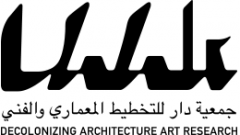
Satellite image showing the location in Jericho, Palestine, in the Jordan valley with the Jordan river to the east and Jerusalem to the west

Satellite image with the DAAR site marked by the red circle

Satellite image showing the outline of the DAAR site, bordering the heritage site known as Hisham’s palace in the Qaser Hisham Archaeological Park
Characteristics
The site in Jericho, Palestine is one of several commitments to privately owned properties as part of the long term project commoning the private. The rural property is a 4 dunam (4000 sqm) farm. Bordering the farm are mature palm trees bearing dates, planted around a field of diverse edible crops. In the west is a small structure containing a walled garden, a small indoor space with a front porch and a small water basin. A farmer who lives nearby tends to the land and uses the structure while working there. The farm borders the historic site known as Hisham’s palace (743-744 AD).
Hisham bin AbdulMalek Palace is located to the northern side of the city of Jericho and is considered one of the most important monuments in Palestine. The palace was destroyed by a violent earthquake that struck the area around the year 749 AD, before its construction was completed. It was partially reused in the Abbasid and Ayyubid periods. The Palestinian Mandate Department of Antiquities excavated the site between 1935-1948. Excavations were renewed in 2006 under the supervision of the Palestinian Antiquities Department. The palace houses one of the largest ancient mosaic panels in the world at about 827 square meters, still in its original location. The mosaic was discovered in the 1930s and was covered under layers of dirt and remained so to protect it from climate influences until its restoration. In 2016, with help from the Japanese International Development Agency, archaeologists and the Palestinian Ministry of Tourism and Antiquities restored and maintained the mosaics. The famous “tree of life” mosaic is on the floor of the bath house. The site remains a popular tourist destination. Source
Vision
DAAR intends to create a gathering space for local and international architects, designers, artists and other creative practitioners to experiment on decolonial practice, commoning and sustainable land use practices. The wish is to allow those interested to independently work and reside on the land, in collaboration with DAAR and others. The farm in Jericho will exist in a network of sites including a farm in Diso, Italy and a summer house in Stavsnäs, Sweden that allow for an exchange of culture and knowledge beyond the confines of European institutions and national borders.
Construction
The first step of our interventions is a pair of containers containing basic infrastructure and sleeping spaces for a small group, to facilitate longer stays on site. The two containers along with the existing building form a courtyard with a view of the fields, intended for gatherings and communal cooking. The containers are chosen for their moveability and minimal impact on the site, to create flexibility for future interventions
Planned construction viewed from the entrance of the property, the existing structure on the left side
View from the courtyard formed by the existing structure and the new containers. The roof structure covering Hisham’s palace is visible through the moving metal gates
Images by Noor Abuharthieh and Herman Hjorth Berge
Jericho, Palestine (2012)
Our first exploration of a DAAR residence in Jericho took the form of a hybrid structure intended to be a useable residential space as well as an interactive art installation, a sort of living museum of our practice. This design was made in close collaboration with Husam Abusalem and although not realized remains an inspiration for possible future interventions.
Visuals by Husam Abusalem




